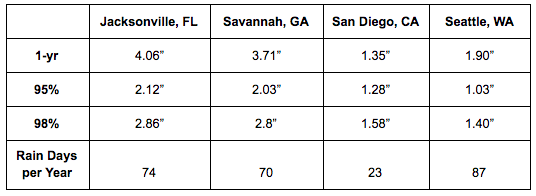If you’re not familiar with low-impact development (LID), you may want to keep reading before building your next facility or warehouse. Thanks to recent changes in LEED requirements, we’re going to see an increase in projects utilizing LID in the near future.
What exactly is low-impact development? How can you make the most of LID and maximize it when applying for LEED certification? Let’s unpack what it means for your next project.
What is low-impact development?
According to the EPA, “the term low impact development (LID) refers to systems and practices that use or mimic natural processes that result in the infiltration, evapotranspiration or use of stormwater in order to protect water quality and associated aquatic habitat.”
In other words, it’s a way to manage stormwater runoff by using the natural environment. The goal is to engineer stormwater management into your site design while conserving natural areas and minimizing the development impact on hydrology.
For more than a decade, Section 438 of the Energy Independence and Security Act of 2007 has required all federal government facilities to incorporate LID. Now, LEED v4 is placing a greater emphasis on LID and requiring it to meet certain credits.
Earning 6 LEED points with low-impact development
Designing low-impact development into your site can earn you up to six points towards LEED certification. Let’s look at the credits in question and how to maximize them.
Rainwater management credit (2 to 3 points)
Under LEED v4, any site must store, without discharge, the entire volume of stormwater runoff for the “95% rainfall event” to meet the rainwater management credit. That means you will likely need bioretention basin(s) on the property capable of storing that volume of water without discharging it, unless you consider more extreme measures of a green roof or cisterns for the equivalent volume.
The water in a bioretention basin is stored there until it is returned to the environment by evapotranspiration (when plants absorb the water and release it as vapor back into the atmosphere) or infiltration (the process by which water enters the soil and recharges streams, lakes, rivers and underground aquifers).
The “95% rainfall event” number is calculated upon 30 years worth of rainfall data. Of course, this varies greatly by location, especially because how it rains looks different in different places.
For example, it rains more often in Washington State than it does in Florida. However, Washington’s 95% rainfall total is significantly smaller, because when it does rain in Florida, it rains hard. Fewer but more powerful storms skews a location’s “95% rainfall” number higher, because it has a smaller data set of total rain events.
Here’s an example of one-year rainfall totals for four different cities compared to their respective 95% and 98% rainfall event totals as well as the average number of rainfall days per year over a 30-year period:

As you can see, there isn’t a predictable pattern because of the variation. My point: You can’t automatically assume the size of the bioretention basin you will need. An experienced partner can help you calculate the proper basin according to your needs and incorporate it into your site design.
Protect and restore habitat credit (2 points)
To earn this credit, you must preserve a certain area of the site in its natural state or engineer an area to match the natural state.
According to USGBC, you must “have in place native or adapted vegetation covering a minimum of 25% of the total site area (excluding the building footprint) or 5% of the total site area (including the building footprint), whichever is greater.”
If you create a bioretention basin on-site, be sure to re-plant similar vegetation to qualify for the protect and restore habitat credit. You’ll get the best of both worlds.
Open space credit (1 point)
Finally, you can turn your bioretention basin into an area that people can enjoy — and qualify for the open space credit.
Rather than fence off this area, make it accessible to people with a sidewalk. You can create a nice space where employees can take a walk, appreciate nature and enjoy their lunch break — and you’ll earn a point towards LEED certification.
Do you have specific questions about low-impact development? Wondering how to maximize LEED certification for your next project? Comment below or email me at foodforthought@stellar.net



